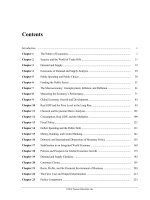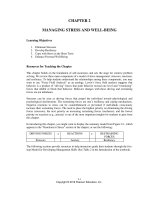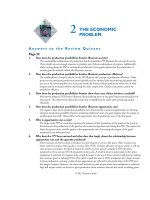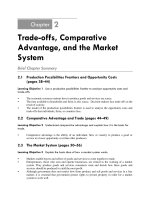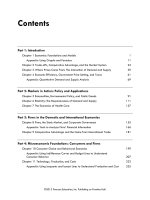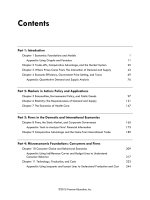Test bank and solution manual of economics 5e by hubbard (2)
Bạn đang xem bản rút gọn của tài liệu. Xem và tải ngay bản đầy đủ của tài liệu tại đây (1.79 MB, 53 trang )
Contents
Part 1: Introduction
Chapter 1 Economics: Foundations and Models
1
Appendix: Using Graphs and Formulas
11
Chapter 2 Trade-offs, Comparative Advantage, and the Market System
25
Chapter 3 Where Prices Come From: The Interaction of Demand and Supply
43
Chapter 4 Economic Efficiency, Government Price Setting, and Taxes
69
Appendix: Quantitative Demand and Supply Analysis
76
Part 2: Markets in Action: Policy and Applications
Chapter 5 Externalities, Environmental Policy, and Public Goods
97
Chapter 6 Elasticity: The Responsiveness of Demand and Supply
121
Chapter 7 The Economics of Health Care
147
Part 3: Firms in the Domestic and International Economies
Chapter 8 Firms, the Stock Market, and Corporate Governance
165
Appendix: Tools to Analyze Firms’ Financial Information
175
Chapter 9 Comparative Advantage and the Gains from International Trade
189
Part 4: Microeconomic Foundations: Consumers and Firms
Chapter 10 Consumer Choice and Behavioral Economics
Appendix: Using Indifference Curves and Budget Lines to Understand
Consumer Behavior
Chapter 11 Technology, Production, and Costs
Appendix: Using Isoquants and Isocost Lines to Understand Production and Cost
©2015 Pearson Education, Inc.
209
217
233
244
iv
Contents
Part 5: Market Structure and Firm Strategy
Chapter 12 Firms in Perfectly Competitive Markets
267
Chapter 13 Monopolistic Competition: The Competitive Model in a More
Realistic Setting
293
Chapter 14 Oligopoly: Firms in Less Competitive Markets
313
Chapter 15 Monopoly and Antitrust Policy
335
Chapter 16 Pricing Strategy
359
Part 6: Labor Markets, Public Choice, and the Distribution of Income
Chapter 17 The Markets for Labor and Other Factors of Production
373
Chapter 18 Public Choice, Taxes, and the Distribution of Income
401
Part 7: Macroeconomic Foundations and Long-Run Growth
Chapter 19 GDP: Measuring Total Production and Income
421
Chapter 20 Unemployment and Inflation
441
Chapter 21 Economic Growth, the Financial System, and Business Cycles
469
Chapter 22 Long-Run Economic Growth: Sources and Policies
489
Part 8: Short-Run Fluctuations
Chapter 23 Aggregate Expenditure and Output in the Short Run
Appendix: The Algebra of Macroeconomic Equilibrium
Chapter 24 Aggregate Demand and Aggregate Supply Analysis
Appendix: Macroeconomic Schools of Thought
511
524
537
548
Part 9: Monetary and Fiscal Policy
Chapter 25 Money, Banks, and the Federal Reserve System
561
Chapter 26 Monetary Policy
585
Chapter 27 Fiscal Policy
613
Appendix: A Closer Look at the Multiplier
Chapter 28 Inflation, Unemployment, and Federal Reserve Policy
©2015 Pearson Education, Inc.
620
645
Contents
v
Part 10: The International Economy
Chapter 29 Macroeconomics in an Open Economy
667
Chapter 30 The International Financial System
691
Appendix: The Gold Standard and the Bretton Woods System
©2015 Pearson Education, Inc.
697
Preface
Features of this Instructor’s Manual
Each chapter of this Instructor’s Manual contains the following elements:
Chapter Summary: An overview of the main economic concepts covered.
Learning Objectives: A list of the student learning goals listed at the beginning of each text chapter.
Chapter Outline with Teaching Tips: Detailed descriptions of the economic concepts in the book, key
term definitions, and teaching tip boxes. The teaching tip boxes include recommendations on how to
integrate key figures.
Extra Solved Problems: Each chapter of the main text has a Solved Problem to support two of the
chapter’s learning objectives. This Instructor’s Manual includes Solved Problems for the remaining
learning objectives. You can assign these extra Solved Problems as homework or present them during
classroom lectures.
Extra Economics in Your Life: Each chapter of the book opens and closes with a special feature entitled
Economics in Your Life that emphasizes the connection between the material and the students’ personal
experiences and questions. This Instructor’s Manual includes an extra Economics in Your Life for each
chapter to present in class.
Extra Making the Connection: Each chapter of the main text has two or more Making the Connection
features to provide real-world reinforcement of key concepts. This Instructor’s Manual includes extra
Making the Connections to present in class.
Solutions to Review Questions and Problems and Applications: Each chapter of this Instructor’s
Manual includes solutions to all questions and problems in the main text:
Solutions to the two Thinking Critically questions that accompany the An Inside Look newspaper
feature located at the end of each chapter
Solutions to the end-of-chapter Review Questions
Solutions to the end-of-chapter Problems and Applications
Revisions to the Digital Assets and to the Main Text
If you used Hubbard/O’Brien, Economics, fourth edition, here are a summary of the new digital assets
available and a Transition Guide, with page numbers, that shows the changes the authors made to the
main text. Knowing about these changes will help you revise your current teaching notes and class
presentations.
©2015 Pearson Education, Inc.
viii
Preface
New digital features located in MyEconLab
MyEconLab is a unique online course management, testing, and tutorial resource. It is included with the
e-text version of the book or as a supplement to the print book. Students and instructors will find the
following new online resources to accompany the fifth edition:
Videos: There are approximately 100 Making the Connection features in the book that provide realworld reinforcement of key concepts. Each feature is now accompanied by a short video of the author
explaining the key point of that Making the Connection. Each video is approximately two minutes
long and includes visuals, such as new photos or graphs, that are not in the main book. The goal of
these videos is to summarize key content and bring the applications to life. Our experience is that
many students benefit from this type of online learning.
Concept Checks: Each section of every chapter concludes with an online Concept Check that
contains one or two multiple choice, true/false, or fill-in questions. These checks act as “speed
bumps” that encourage students to stop and check their understanding of fundamental terms and
concepts before moving on to the next section. The goal of this digital resource is to help students
assess their progress on a section-by-section basis, so they can be better prepared for homework,
quizzes, and exams.
Animations: Graphs are the backbone of introductory economics, but many students struggle to
understand and work with them. Each numbered figure in the text has a supporting animated version
online. The goal of this digital resource is to help students understand shifts in curves, movements
along curves, and changes in equilibrium values. Having an animated version of a graph helps
students who have difficulty interpreting the static version found in the printed text.
Interactive Solved Problems: Many students have difficulty applying economic concepts to solving
problems. The goal of this digital resource is to help students overcome this hurdle by giving them a
model of how to solve an economic problem by breaking it down step by step. Each Solved Problem
is accompanied by a similar problem online, so students can have more practice and build their
problem-solving skills. These interactive tutorials help students learn to think like economists and
apply basic problem-solving skills to homework, quizzes, and exams. The goal is for students to build
skills they can use to analyze real-world economic issues they hear and read about in the news.
Graphs Updated with Real-Time Data from FRED: Figure 7.5, “Spending on Health Care around
the World,” Figure 8.2, “Movements in Stock Market Indexes,” and Figures 9.1 and 9.3, both on
international trade, are continuously updated online with the latest available data from FRED (Federal
Reserve of Economic Data), which is a comprehensive, up-to-date data set maintained by the Federal
Reserve Bank of St. Louis. Students can display a pop-up graph that shows new data plotted in the
graph. The goal of this digital feature is to help students understand how to work with data and
understand how including new data affects graphs.
Interactive Problems and Exercises Updated with Real-Time Data from FRED: Chapter 8,
“Firms, the Stock Market, and Corporate Governance,” includes two real-time data exercises that use
the latest data from FRED. The goal of this digital feature is to help students become familiar with
this key data source, learn how to locate data, and develop skills in interpreting data.
©2015 Pearson Education, Inc.
Preface
Transition Guide: Hubbard/O’Brien 4th Edition versus the New 5th Edition
Chapter 1: Economics: Foundations and Models
4e page 4e Content
5e page
3
20–21
Why Are Some Doctors Leaving
Private Practice?
Inside Look: Doctors Moving Less,
Retiring Later
3
18–19
5e Content
NEW: Is the Private Doctor’s Office Going to
Disappear?
NEW Inside Look: Look into Your Smartphone
and say “Ahh”
Chapter 2: Trade-offs, Comparative Advantage, and the Market System
4e page 4e Content
5e page 5e Content
39
42
43
Managers Making Choices at BMW
Solved Problem 2.1: Drawing a
Production Possibilities Frontier for
Rosie’s Boston Bakery
Making the Connection: Facing
Trade-offs in Health Care Spending
37
40
NEW Managers at Tesla Motors Face Trade-offs
Solved Problem 2.1: Drawing a Production
Possibilities Frontier for Tesla Motors
n/a
Moved to 5e IM
49
NEW Making the Connection: Comparative
Advantage, Opportunity Cost, and Housework
NEW Making the Connection: Who Owns The
Wizard of Oz?
NEW Inside Look: What’s on the Horizon at
Mercedes-Benz
57
60–61
Inside Look: Managers at General
Motors Approve Production of a
Plug-in Cadillac
60–61
Chapter 3: Where Prices Come From: The Interaction of Demand and Supply
4e page 4e Content
5e page 5e Content
69
73
74
77
88
92–93
The Tablet Computer Revolution
Making the Connection: Are Quiznos
Sandwiches Normal Goods and
Subway Sandwiches Interior Goods?
69
n/a
NEW: Smartphones: The Indispensible Product?
Moved to 5e IM
73
NEW Making the Connection: Are Tablet
Computers Substitutes for E-Readers?
Moved to 5e IM
74
NEW Making the Connection: Coke and Pepsi
Are Hit by U.S. Demographics
Moved to 5e IM
77
NEW Making the Connection: Forecasting the
Demand for iPhones
Moved to 5e IM
88–89
NEW Solved Problem 3.4: What Has Caused the
Decline in Beef Consumption?
New Inside Look: Google and Apple Face
Demand and Supply Concerns in the Smartphone
Market
Making the Connection: The Aging
of the Baby Boom Generation
Making the Connection: Forecasting
the Demand for iPads
Solved Problem 3.4: High Demand
and Low Prices in the Lobster
Market?
Inside Look: Will Shortage of
Display Screens Derail Computer
Tablet Sales?
92–93
©2015 Pearson Education, Inc.
ix
x
Preface
Chapter 4: Economic Efficiency, Government Price Setting, and Taxes
4e page 4e Content
5e page 5e Content
101
122–123
Should the Government Control
Apartment Rents?
Inside Look: .and the RentControlled Apartment Goes
to…Actress Faye Dunaway!
101
122–123
NEW: The Sharing Economy, Phone Apps, and
Rent Control
NEW Inside Look: Does the Sharing Economy
Increase Efficiency?
Chapter 5: Externalities, Environmental Policy, and Public Goods
4e page 4e Content
5e page 5e Content
148
Solved Problem 5.3
150–151
152
162–163
Inside Look: Pros and Cons of
Tougher Air Pollution Regulation
n/a
Moved to 5e IM
NEW Solved Problem 5.3: Dealing with the
Externalities of Car Driving
NEW section: The End of the Sulfur Dioxide
Cap-and-Trade System
See MyEconLab for current news articles,
summaries, and questions for Chapter 5 onward.
Chapter 6: Elasticity: The Responsiveness of Demand and Supply
4e page 4e Content
5e page 5e Content
Moved to 5e IM
184–185 Making the Connection: Determining n/a
the Price Elasticity of Demand
through Market Experiments
Price Elasticity, Cross-Price
Elasticity, and Income Elasticity in
the Market for Alcoholic Beverages
Inside Look: Gasoline Price
Increases Change Consumer
Spending Patterns, May Stall
Recovery
186
Heavily revised
n/a
See MyEconLab for current news articles,
summaries, and questions.
Chapter 7: The Economics of Health Care
4e page 4e Content
5e page
5e Content
205
Small Businesses Feel the Pinch of
Escalating Health Care Costs
Why is it difficult for people who are
seriously ill to buy health insurance?
205
Figure 7.1: The Average Height of
Adult Males
Figure 7.3, Sources of Health
Insurance
n/a
NEW: How Much Will You Pay for Health
Insurance?
NEW: Is Your Take-Home Pay Affected by What
Your Employer Spends on Your Health
Insurance?
Cut
187
196–197
205
208
209
205
209
216–217
217
Solved Problem 7.3: Dealing with
Adverse Selection
n/a
218
222
Now Figure 7.2. Figure converted from a pie chart
to bar graphs.
NEW Solved Problem 7.3: If You Are Young and
Healthy, Should You Buy Health Insurance?
Moved to 5e IM
NEW Figure 7.4, “The Effect of a Positive
Externality on the Market for Vaccinations” plus
analysis.
NEW Making the Connection: Are U.S. Firms
Handicapped by Paying for Their Employees’
Health Insurance (previously in Chapter 17).
Includes a demand and supply graph.
©2015 Pearson Education, Inc.
Preface
4e page
227
230–231
4e Content
Making the Connection: Health
Exchanges, Small Businesses, and
Rising Medical Costs
Inside Look: Health Care Spending
Expected to Increase 70 Percent by
End of Decade
5e page
5e Content
225
NEW Figure 7.8, “The Effect of the Third-Party
Payer System on the Demand for Medical
Services” plus analysis.
Moved to 5e IM
n/a
n/a
xi
See MyEconLab for current news articles,
summaries, and questions.
Chapter 8: Firms, the Stock Market, and Corporate Governance
4e page 4e Content
5e page 5e Content
237
240
242
253
256–257
How Can You Buy a Piece of
Facebook?
Making the Connection: How
Important Are Small Businesses to
the U.S. Economy
Solved Problem 8.2: Does the
Principal-Agent Problem Apply to
the Relationship between Managers
and Employees?
237
240
NEW: Facebook Learns the Benefits and Costs of
Becoming a Publicly Owned Firm
NEW graph added to this Making the Connection
n/a
Moved to the 5e IM
242
NEW Solved Problem 8.2: Should a Firm’s CEO
Also Be the Chairman of the Board?
CUT.
254
NEW Making the Connection: The Ups and
Downs of Investing in Facebook
See MyEconLab for current news articles,
summaries, and questions.
Making the Connection: Are Buyers
of Facebook Stock Getting a Fair
Deal?
Inside Look: Shares of Private
Companies Available to Qualified
Investors
n/a
Chapter 9: Comparative Advantage and the Gains from International Trade
4e page 4e Content
5e page 5e Content
273
273
276
291
298–299
Does the Federal Government’s ‘Buy
American’ Policy Help U.S. Firms?
Have You Heard of the ‘buy
American’ provision?
Making the Connection: How
Caterpillar Depends on International
trade
271
NEW: Saving Jobs in the U.S. Tire Industry?
271
Have You Heard of the Tariff on Chinese Tires?
n/a
Moved to 5e IM
273
NEW Making the Connection: Goodyear and the
Tire Tariff
Moved to 5e IM
289
NEW Making the Connection: The Effect on the
Economy of the Tariff on Chinese Tires
n/a
See MyEconLab for current news articles,
summaries, and questions.
Making the Connection: Save Jobs
Making Hangers…and Lose Jobs in
Dry Cleaning
Inside Look: Did Home Depot
Knowingly Defy the “Buy
American” Policy?
©2015 Pearson Education, Inc.
xii
Preface
Chapter 10: Consumer Choice and Behavioral Economics
4e page 4e Content
5e page 5e Content
309
321–322
Can Justin Bieber and Ozzy
Osbourne Get you to Shop at Best
Buy?
Making the Connection: Why Do
Firms Pay Tom Brady to Endorse
Their Products?
305
NEW: J.C. Penney Learns That Simplifying
Prices Isn’t Simple
317–318
This content is integrated into a paragraph.
326
NEW section on The Behavioral Economics of
Shopping
NEW Making the Connection: J.C. Penney Meets
Behavioral Economics
Moved to 5e IM
327
330
332–333
Solved Problem 10.4: How Do You
Get People to Save More of Their
Income?
Inside Look: Findings Are Mixed on
the Success of Celebrity
Endorsements
See MyEconLab for current news articles,
summaries, and questions.
Chapter 11: Technology, Production, and Costs
4e page 4e Content
5e page
353
369
374–375
Sony Uses a Cost Curve to
Determine the Prices of Radios
Long-Run Average Cost Curves for
Bookstores
Inside Look: New Technology Could
Lower the Cost of Solar Panels
351
367
5e Content
NEW: Fracking, Marginal Costs, and Energy
Prices
Revised to Long-Run Average Cost Curves for
Automobile Factories
See MyEconLab for current news articles,
summaries, and questions.
Chapter 12: Firms in Perfectly Competitive Markets
4e page 4e Content
5e page
5e Content
407
Moved to 5e IM
Making the Connection Losing
Money in the Medical Screening
Industry
402–403
408–409
422–423
Solved Problem 12.4: When to Pull
the Plug on a Movie
Inside Look: Organic Farming on the
Decline in the United Kingdom
404–405
NEW Making the Connection: Losing Money in
the Solar Panel Industry
NEW Solved Problem 12.4: When to Pull the
Plug on a Movie
See MyEconLab for current news articles,
summaries, and questions.
Chapter 13: Monopolistic Competition: The Competitive Model in a More Realistic Setting
4e page 4e Content
5e page 5eContent
444–445
Making the Connection: Netflix:
Differentiated Enough to Survive?
Moved to 5e IM
438
450–451
Inside Look: Starbucks Expands Into
Juice Business
NEW Making the Connection: Peter Theil, eCigarettes, and the Monopoly in Monopolistic
Comeptition
See MyEconLab for current news articles,
summaries, and questions.
©2015 Pearson Education, Inc.
Preface
xiii
Chapter 14: Oligopoly: Firms in Less Competitive Markets
4e page 4e Content
5e page 5e Content
459
Competition in the Computer Market
465
Solved Problem 14.2: Is Advertising
a Prisoner’s Dilemma for Coca-Cola
and Pepsi?
451
Moved to 5e IM
447–458
475
478–479
NEW: Competition in the Video Game Console
Market
Figure 14.8: Five Competitive Forces
Model
Inside Look: Can Intel’s “Ultrabook”
Compete with Apple’s MacBook
Air?
NEW Solved Problem 14.2: Is Same-Day
Delivery a Prisoner’s Dilemma for Wal-Mart and
Amazon?
CUT
See MyEconLab for current news articles,
summaries, and questions.
Chapter 15: Monopoly and Antitrust Policy
4e page 4e Content
5e page
5e Content
487
487
NEW A Monopoly on Lobster Dinners in Maine?
Is There a Monopoly in Your Dorm?
490
494
507
Is Cable Television a Monopoly?
Why Can’t I Watch the NFL
Network?
Making the Connection: The End of
the Christmas Plant Monopoly
477
477
Moved to 5e IM
480–481
NEW Making the Connection: Does Hasbro Have
a Monopoly on Monopoly?
Moved to 5e IM
484–485
NEW Solved Problem 15.2: Can a Restaurant Be
a Natural Monopoly?
Solved Problem 15.2: Is the
OpenTable Web Site a Natural
Monopoly?
Making the Connection: Should
AT&T Have Been Allowed to Merge
with T-Mobile?
Moved to IM
494–495
510–511
Inside Look: The End of the Cable
TV Monopoly?
Chapter 16: Pricing Strategy
4e page 4e Content
530
See MyEconLab for current news articles,
summaries, and questions.
5e page
Making the Connection: Price
Discrimination with a Twist at
Netflix
Inside Look: Paying for the Right to
Pay to See the Kansas Jayhawks Play
Football
5e Content
Moved to 5e IM
518–519
538–539
NEW Making the Connection: Did Apple Violate
the Law in Pricing e-Books?
NEW Making the Connection: The Internet
Leaves You Open to Price Discrimination
See MyEconLab for current news articles,
summaries, and questions.
©2015 Pearson Education, Inc.
xiv
Preface
Chapter 17: The Markets for Labor and Other Factors of Production
4e page 4e Content
5e page 5e Content
545
559
572–573
Why Did the San Diego Padres Trade
Their Best Player to the Boston Red
Sox?
Making the Connection: Are U.S.
Firms Handicapped for Their
Employees’ Health Insurance
Inside Look: Basketball Coaches’
Salaries: A March to Madness?
533
NEW Who Is Zach Greinke and Why Is He Being
Paid $147 Million?
544
NEW Making the Connection: Veterinarians Fall
Victim to Demand and Supply
Moved to Chapter 7, page 222
Moved
to Ch. 7,
p. 222
See MyEconLab for current news articles,
summaries, and questions.
Chapter 18: The Tax System and the Distribution of Income
4e page 4e Content
5e page 5e Content
569
606–607
Inside Look: Should a Tax on Soda
Be used to Reduce Budget Deficits?
New Making the Connection: What Explains the 1
Percent?
See MyEconLab for current news articles,
summaries, and questions.
Chapter 19: GDP: Measuring Total Production and Income
4e page 4e Content
5e page 5e Content
622
Making the Connection: Will U.S.
Consumers Be Spending Less?
603
Moved to 5e IM
610–611
NEW Making the Connection: Adding More of
Lady Gaga to GDP
See MyEconLab for current news articles,
summaries, and questions.
Chapter 20: Unemployment and Inflation
4e page 4e Content
5e page
5e Content
641
629
NEW Caterpillar Announces Plans to Lay Off
Worker
Moved to 5e IM
Inside Look: Analysts Lower
Estimates for New Car Sales in 2011
and 2012
653–54
661
NEW Bank of America Announces
Plans to Lay Off 30,000 Employees
Making the Connection: How Should
We Categorize the Unemployment at
Bank of America?
Solved Problem 20.5: Calculating
Real Average Hourly Earnings
641–42
649
668–69
Inside Look: Will Pink slips Be in the
Mail for Postal Workers?
NEW Making the Connection: How Should We
Categorize Unemployment at Caterpillar?
Moved to 5e IM
NEW Solved Problem 20.5: Calculating Real
Wages at Caterpillar
See MyEconLab for current news articles,
summaries, and questions.
Chapter 21: Economic Growth, the Financial System, and Business Cycles
4e page 4e Content
5e page 5e Content
677
684–85
Growth and the Business Cycle at
Boeing
Making the Connection: What
Explains Rapid Economic Growth in
Botswana?
665
NEW Economic Growth and the Business Cycle
at Whirlpool
Moved to 5e IM
672–73
NEW Making the Connection: Can India Sustain
Its Rapid Growth?
©2015 Pearson Education, Inc.
Preface
xv
4e page
4e Content
5e page
5e Content
697
Section on “The Effect of the
Business Cycle on Boeing”
Inside Look: Airlines Face the
Business Cycle
686
Replaced with “The Effect of the Business Cycle
on Whirlpool”
See MyEconLab for current news articles,
summaries, and questions.
704–705
Chapter 22: Long-Run Economic Growth: Sources and Policies
4e page 4e Content
5e page 5e Content
711
725
Google’s Dilemma in China
Section, “Can the United States
Maintain High Rates of Productivity
Growth”
735
Figure 22.10, “Globalization and
Growth”
Inside Look: Despite a Plan for
Change, Investment Still Spurs
China’s Growth
740–741
699
713
NEW Can China Save General Motors
Heavily revised and expanded and significantly
expanded discussion of the debate over future
U.S. growth. Section renamed to “Is the United
States Headed for Another Productivity
Slowdown?”
Moved to 5e IM
See MyEconLab for current news articles,
summaries, and questions.
Chapter 23: Aggregate Expenditure and Output in the Short Run
4e page 4e Content
5e page 5e Content
755
762–63
Making the Connection: Do Changes
in Housing Wealth Affect
Consumption Spending
Making the Connection: Intel Tries to
Jump Off the Roller Coaster of IT
Spending
737
Moved to 5e IM
749–50
753
782–83
Moved to 5e IM
Inside Look: turnaround Projected for
the Restaurant Industry
NEW Making the Connection: Intel Moves into
Tablets and Perceptual Computing
NEW Making the Connection: The iPhone Is
Made in China … or Is It?
See MyEconLab for current news articles,
summaries, and questions.
Chapter 24: Aggregate Demand and Aggregate Supply Analysis
4e page 4e Content
5e page 5e Content
789–90
811
818–819
826
Making the Connection: How Long
Does It Take to Return to Potential
GDP? Economic Forecasts Following
the Recession of 2007–2009
Inside Look: Smaller Freight
Volumes Signal continued Economic
Troubles (2011 article)
Appendix on Macroeconomics
Schools of Thought
NEW Making the Connection: How Sticky Are
Wages?
Extensively revised and includes a new table
showing the errors in government forecasts.
See MyEconLab for current news articles,
summaries, and questions.
814–815
Revised to include a new section on the Austrian
model.
Chapter 25: Money, Banks, and the Federal Reserve System
4e page 4e Content
5e page 5e Content
829
835
Coca-Cola Dries Up as Money
Floods Zimbabwe
Making the Connection: Do We Still
Need the Penny?
819
NEW Washing Dollar Bills to Save the Economy
of Zimbabwe
Moved to 5e IM
©2015 Pearson Education, Inc.
xvi
Preface
4e page
4e Content
5e page
5e Content
826–27
NEW Making the Connection: Are Bitcoins
Money?
NEW T-accounts added to section on “Open
Market Operations”
See MyEconLab for current news articles,
summaries, and questions.
837–38
856–57
Inside Look: Increased Lending
Boosts Money Supply Growth
Chapter 26: Monetary Policy
4e page 4e Content
5e page
5e Content
865
853
NEW Why Do Businesses Care What the Federal
Reserve Does?
NEW Section of “Fed Forecasts” that includes
NEW Table 26.1: Fed Forecasts of Real GDP
Growth during 2007 and 2008
NEW Figure 26.12: Housing Prices and Housing
Rents
See MyEconLab for current news articles,
summaries, and questions.
Monetary Policy, Toll Brothers, and
the Housing Market
866–67
896–97
Inside Look: Fed Attempts to
Stimulate Housing Market….Again
Chapter 27: Fiscal Policy
4e page 4e Content
5e page
5e Content
909–910
897–98
NEW graph added to this feature that
distinguishes growth in spending on Social
Security from growth in spending on
Medicare/Medicaid.
Revised for clarity: key Figure 27.9, “The
Multiplier Effect of an Increase in Government
Purchases”
NEW Figure 27.14: The Effect of the Stimulus
Package on Federal Expenditures and Revenue
See MyEconLab for current news articles,
summaries, and questions.
Making the Connection: Is Spending
on Social Security and Medicare a
Fiscal Time Bomb
904
912
936–37
Inside Look: Obama Proposes
Additional Spending to Stimulate the
Economy
Chapter 28: Inflation, Unemployment, and Federal Reserve Policy
4e page 4e Content
5e page 5e Content
951
Why Does CarMax Worry about
Monetary Policy?
937
957
974–75
Inside Look: Can the Fed Balance the
Trade-off between Unemployment
and Inflation?
NEW Why Does Parker Hannifin Worry about
Monetary Policy?
NEW Making the Connection: The Debate over
Quantitative Easing with photo of Janet Yellen
See MyEconLab for current news articles,
summaries, and questions.
Chapter 29: Macroeconomics in an Open Economy
4e page 4e Content
5e page
5e Content
933
Moved to 5e IM
Making the Connection: What
Explains the Fall and Rise and Fall of
the Dollar
977–78
1004–5
Inside Look: Struggling Economy
Contributes to a Weak Dollar
NEW Making the Connection: Japanese Firms
Ride the Yen Roller Coaster
See MyEconLab for current news articles,
summaries, and questions.
©2015 Pearson Education, Inc.
Preface
Chapter 30: The International Financial System
4e page 4e Content
5e page
1013
1016
1026–27
1030–31
Airbus Deals with Fluctuating
Exchange Rates
Making the Connection: The
Canadian Province of…Arizona
5e Content
995
NEW Volkswagen Deals with Fluctuating
Exchange Rates
Moved to the 5e IM
1007
NEW Figure 30.5 The Yuan-Dollar Exchange
Rate
Moved to the 5e IM
1008–9
NEW Making the Connection: Why Did Iceland
Recover So Quickly from the Financial Crisis?
See MyEconLab for current news articles,
summaries, and questions.
Making the Connection: Crisis and
Recovery in South Korea
Inside Look: Can Tariffs Offset the
Effect of Overvaluation? (October
2011 article)
xvii
Organizing Your Syllabus
The Instructor’s Manual can be a valuable resource for both experienced and first-time instructors. Both
the textbook and Instructor’s Manual provide comprehensive coverage of economic theory, monetary
policy, fiscal policy, and real-world applications.
Microeconomic Chapters
The microeconomics chapters cover relatively new developments in the field, such as the economics of
information (Chapter 7, “The Economics of Health Care”) and personnel economics (Chapter 17, “The
Markets for Labor and Other Factors of Production”). The authors include business applications in each
chapter and have a dedicated chapter on firms, the stock market, and corporate governance (Chapter 8,
“Firms, the Stock Market, and Corporate Governance”). The comprehensive coverage of microeconomics
and business topics allows instructors to select chapters for diverse groups of students.
Most instructors will not want to cover indifference curve analysis or isoquant and isocost curves, but
those who wish to will find these topics covered in the appendices to Chapter 10, “Consumer Choice and
Behavioral Economics,” and Chapter 11, “Technology, Production, and Costs,” respectively. Chapter 14
of this instructor’s manual, “Oligopoly: Firms in Less Competitive Markets,” includes coverage of the
kinked demand curve that does not appear in the main book.
First-time users of the textbook should be aware that some topics introduced in one chapter are applied in
a later chapter. Chapter 4, “Economic Efficiency, Government Price Setting, and Taxes,” introduces
consumer, producer, and economic surplus to describe the impact of government-imposed price controls.
The appendix to Chapter 4, “Quantitative Demand and Supply Analysis,” explains in detail how
consumer and producer surplus are calculated using linear demand and supply curves. Chapter 9,
“Comparative Advantage and the Gains from International Trade,” uses the same tools to measure the
effect of tariffs and quotas on international trade.
Macroeconomic Chapters
Chapter 19, “GDP: Measuring Total Production and Income,” and Chapter 20, “Unemployment and
Inflation” carefully provide definitions of macroeconomic statistics such as GDP, CPI, and payroll
employment, that dominate news headlines.
©2015 Pearson Education, Inc.
xviii Preface
The comprehensive coverage of macroeconomic models and policy issues allows instructors with
somewhat different course objectives the flexibility to choose different chapter sequences. The authors
provide an overview of issues of long-run growth, business cycles, and the financial system in
Chapter 21, “Economic Growth, the Financial System, and Business Cycles.” Instructors who wish to
explore more deeply the sources of long-run growth and government policies toward growth can also
assign Chapter 22, “Long-Run Economic Growth: Sources and Policies.” Monetary policy has a central
role in the economy, so the book includes two chapters on monetary policy: Chapter 26, “Monetary
Policy,” and Chapter 28, “Inflation, Unemployment, and Federal Reserve Policy.” Chapter 28 discusses
the role of the Fed and inflation targeting with an insider’s perspective.
Chapter 23, “Aggregate Expenditure and Output in the Short Run,” contains a thorough discussion of the
traditional Keynesian 45º-line aggregate expenditure model. Many instructors find this model useful in
introducing students to the short-run relationship between spending and production. However, instructors
may also safely omit Chapter 23 and proceed directly to Chapter 24, “Aggregate Demand and Aggregate
Supply Analysis.”
Chapter 24 carefully develops the AD-AS model and then makes the model dynamic in an optional
section to account better for actual movements in real GDP and the price level. Chapter 24 includes a
three-layer, full-color acetate for the key introductory dynamic AD-AS graph (Figure 24.8, “A Dynamic
Aggregate Demand and Aggregate Supply Model” on page 801.) We created this acetate to help students
see how the graph builds step by step and to help make the graph easier for instructors to present. The
acetate will help instructors who want to use dynamic AD-AS in class but believe the model needs to be
developed carefully. Instructors may safely omit the sections on the dynamic AD-AS model in Chapter 26,
“Monetary Policy” and in Chapter 27, “Fiscal Policy,” without any loss in continuity to the discussion of
macroeconomic theory and policy.
©2015 Pearson Education, Inc.
Preface
xix
The following chart helps you organize your syllabus based on your teaching preferences and objectives:
CORE
Chapter 1: Economics: Foundations
and Models
Chapter 2: Trade-offs, Comparative
Advantage, and the Market
System
Chapter 3: Where Prices Come
From: The Interaction of Demand
and Supply
Chapter 6: Elasticity: The
Responsiveness of Demand and
Supply
Chapter 9: Comparative Advantage
and the Gains from International
Trade
May be delayed until after Ch. 28.
Chapter 11: Technology, Production,
and Costs
POLICY
Chapter 4: Economic Efficiency,
Government Price Setting, and
Taxes
Chapter 5: Externalities,
Environmental Policy, and Public
Goods
This chapter may be delayed until
after Ch. 15.
Chapter 7: The Economics of
Health Care
Chapter 18: Public Choice, Taxes,
and the Distribution of Income
Chapter 26: Monetary Policy
Chapter 27: Fiscal Policy
Chapter 28: Inflation,
Unemployment, and Federal
Reserve Policy
Chapter 12: Firms in Perfectly
Competitive Markets
OPTIONAL
Chapter 1 Appendix: Using Graphs
and Formulas
Chapter 4 Appendix: Quantitative
Demand and Supply Analysis
Chapter 8: Firms, the Stock Market,
and Corporate Governance
Chapter 8 Appendix: Tools to
Analyze Firms’ Financial
Information
Chapter 10: Consumer Choice and
Behavioral Economics
Chapter 10 Appendix: Using
Indifference Curves and Budget
Lines to Understand Consumer
Behavior
Chapter 11 Appendix: Using
Isoquants and Isocost Lines to
Understand Production and Cost
Chapter 16: Pricing Strategy
Chapter 23: Aggregate Expenditure
and Output in the Short Run
Chapter 13: Monopolistic
Competition: The Competitive
Model in a More Realistic Setting
Chapter 23 Appendix: The Algebra
of Macroeconomic Equilibrium
Chapter 14: Oligopoly: Firms in Less
Competitive Markets
Chapter 24 Appendix:
Macroeconomic Schools of
Thought
Chapter 15: Monopoly and Antitrust
Policy
Chapter 27 Appendix: A Closer
Look at the Multiplier
May be covered after Ch. 12.
Chapter 17: The Markets for Labor
and Other Factors of Production
Chapter 29: Macroeconomics in an
Open Economy
Chapter 19: GDP: Measuring Total
Production and Income
Chapter 30: The International
Financial System
Chapter 20: Unemployment and
Inflation
Chapter 30 Appendix: The Gold
Standard and the Bretton Woods
System
Chapter 21: Economic Growth, the
Financial System, and Business
Cycles
Chapter 22: Long-Run Economic
Growth: Sources and Policies
Chapter 24: Aggregate Demand
and Aggregate Supply Analysis
©2015 Pearson Education, Inc.
xx
Preface
CORE
POLICY
OPTIONAL
This chapter carefully develops the
AD-AS model and then makes the
model dynamic to better account
for actual movements in real GDP
and the price level. The dynamic
AD-AS model is covered in an
optional section, which instructors
can omit without loss of continuity.
Chapter 25: Money, Banks, and the
Federal Reserve System
MyEconLab for Instructors & Students
MyEconLab is a unique online course management, testing, and tutorial resource.
MyEconLab for the Professor
Instructors can choose how much or how little time to spend setting up and using MyEconLab.
Each chapter contains two preloaded homework exercise sets that can be used to build an individualized
study plan for each student. These study plan exercises contain tutorial resources, including instant
feedback, links to the appropriate learning objective in the eText, pop-up definitions from the text, and
step-by-step guided solutions, where appropriate. After the initial setup of the course by the instructor,
student use of these materials requires no further instructor setup. The online grade book records each
student’s performance and time spent on the tests and study plan and generates reports by student or
chapter. Alternatively, instructors can fully customize MyEconLab to match their course exactly,
including reading assignments, homework assignments, video assignments, current news assignments,
and quizzes and tests. Assignable resources include:
Preloaded exercise assignments sets for each chapter that include the student tutorial resources
mentioned earlier
Preloaded quizzes for each chapter that are unique to the text and not repeated in the study plan or
homework exercise sets
Study plan problems that are similar to the end-of-chapter problems and numbered exactly like the
book to make assigning homework easier
Real-Time-Data Analysis Exercises, marked with a red circle icon, allow students and instructors to
use the very latest data from FRED. By completing the exercises, students become familiar with a key
data source, learn how to locate data, and develop skills in interpreting data.
©2015 Pearson Education, Inc.
Preface
xxi
In the eText available in MyEconLab, select figures labeled MyEconLab Real-time data allow
students to display a pop-up graph updated with real-time data from FRED.
Current News Exercises, provide a turnkey way to assign gradable news-based exercises in
MyEconLab. Each week, Pearson scours the news, finds a current economics article, creates exercises
around these news articles, and then automatically adds them to MyEconLab. Assigning and grading
current news-based exercises that deal with the latest economic events and policy issues has never
been more convenient.
Experiments in MyEconLab are a fun and engaging way to promote active learning and mastery of
important economic concepts. Pearson’s Experiments program is flexible and easy for instructors and
students to use.
Single-player experiments allow your students to play against virtual players from anywhere at any
time, so long as they have an Internet connection.
Multiplayer experiments allow you to assign and manage a real-time experiment with your class.
Pre- and post-questions for each experiment are available for assignment in MyEconLab. For a
complete list of available experiments, visit www.myeconlab.com.
Test Item File questions that allow you to assign quizzes or homework that will look just like your
exams
©2015 Pearson Education, Inc.
xxii
Preface
Econ Exercise Builder, which allows you to build customized exercises. Exercises include multiplechoice, graph drawing, and free-response items, many of which are generated algorithmically so that
each time a student works them, a different variation is presented.
MyEconLab grades every problem type except essays, even problems with graphs. When working
homework exercises, students receive immediate feedback with links to additional learning tools.
Customization and Communication
MyEconLab in MyLab/Mastering provides additional optional customization and communication tools.
Instructors who teach distance-learning courses or very large lecture sections find the MyLab/Mastering
format useful because they can upload course documents and assignments, customize the order of
chapters, and use communication features such as Document Sharing, Chat, ClassLive, and Discussion
Board.
MyEconLab: Moving to a New Edition
When a new edition of your textbook publishes, you do not have to recreate all your assignments. You
can import assignments from a previous edition of the same book.
Not every exercise from the previous edition is included in the new edition. Once your assignments have
been imported, a list of any exercises that did not convert will be displayed as well as emailed to you.
Please use this list to help you find suitable replacement exercises in the new edition. You must first allow
assignments from old edition to be imported.
In the old edition course:
1. Click on Homework Manager.
2. Click Show All to see all assignments (HW, Quizzes, Tests).
3. Choose Change Assignment Settings from Drop down menu.
©2015 Pearson Education, Inc.
Preface xxiii
4. Check box for Allow Import.
5. Click Update.
Import Assignments into New Edition Course
1. Create course based on new edition of the book.
2. Click on Homework Manager.
3. Under Create Assignment, choose Import/Copy Assignments from another course.
©2015 Pearson Education, Inc.
xxiv Preface
4. Choose Convert and import assignments from courses using a previous edition of this book or
related books with similar coverage.
5. Click Next.
6. Choose if you wish to convert from one of your courses or one from another instructor at your
institution.
7. Click Next.
©2015 Pearson Education, Inc.
Preface
xxv
8. Click Next.
9. Select all the assignments you wish to import.
10. Click Import
You will then see a summary screen detailing which exercises were not converted, so you can find
replacements. This same information will be sent to your MyEconLab registered email address.
©2015 Pearson Education, Inc.
xxvi Preface
MyEconLab for the Student
MyEconLab puts students in control of their learning through a collection of testing, practice, and study
tools tied to the online, interactive version of the textbook and other media resources.
Students can study on their own, or they can complete assignments created by their instructor. Within
MyEconLab’s structured environment, students practice what they learn, test their understanding, and
pursue a personalized study plan generated from their performance on sample tests and from quizzes
created by their instructors. In Homework or Study Plan mode, students have access to a wealth of tutorial
features, including:
Instant feedback on exercises that helps students understand and apply the concepts;
Links to the eText to promote reading of the text just when the student needs to revisit a concept or
explanation
Step-by-step guided solutions that force students to break down a problem in much the same way an
instructor would do during office hours
Pop-up summaries of the appropriate learning objective to remind students of key ideas while
studying
Pop-up key term definitions from the eText to help students master the vocabulary of economics
Links to the important features of the eText, such as Solved Problems, Making the Connection, An
Inside Look, and Don’t Let This Happen to You
A graphing tool that is integrated into the various exercises to enable students to build and manipulate
graphs so that students better understand how concepts, numbers, and graphs connect
©2015 Pearson Education, Inc.
Preface xxvii
Additional MyEconLab Tools
MyEconLab includes the following additional features:
eText—In addition to the portions of eText available as pop-ups or links, a fully searchable eText is
available for students who wish to read and study in a fully electronic environment.
Print upgrade—For students who wish to complete assignments in MyEconLab but read in print,
Pearson offers registered MyEconLab users a loose-leaf version of the print text at a significant
discount.
Glossary flashcards—Every key term is available as a flashcard, allowing students to quiz
themselves on vocabulary from one or more chapters at a time.
MySearchLab-----Research MySearchLab provides extensive help on the research process and four
exclusive databases of credible and reliable source material, including the New York Times, the
Financial Times, and peer-reviewed journals.
Other Supplements for Instructors
Four Test Item Files
TestGen Computerized Test Program
PowerPoint Lecture Presentation
Instructor’s Resource Disk with Test Item Files, Instructor’s Manual, and PowerPoint presentations
Classroom Response Systems
BlackBoard and WebCT Course Content
Four Test Item Files (in print format and electronic TestGen format)
Four Test Item Files accompany the text. Each Test Item File includes more than 2,000 multiple-choice,
short answer, and graphing questions.
©2015 Pearson Education, Inc.

